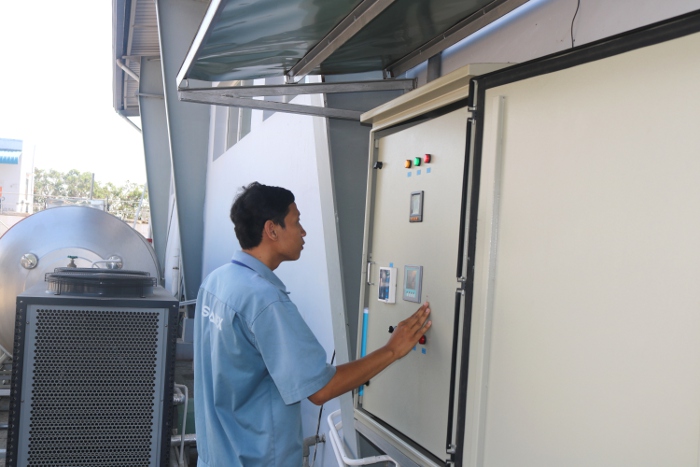To support the enterprises in their application of key solutions to economical and efficient use of energy in production and business, Electricity of Vietnam (EVN) in cooperation with the relevant units developed the ESCO model (Energy Savings Company). Up to now, the ESCO model has been clearly effective, it does not only help enterprises save production costs, improve competitiveness, but also contributes to environmental protection, and ensures the energy security for the country.
To support enterprises in the southern provinces to participate in the ESCO model, EVN directed its subordinate units to implementfinancial solutions of investment andtechnical solutions for businesses to change equipment and technology in the field of energy savings. Accordingly, EVN has assigned the task to the SouthernPower Corporation (EVNSPC) to fund the installation of industrial hot water supply system for customers who have an average power consumption of over 20,000 kWh/month. On that basis, EVNSPC signed the memorandum for collaboration with Bach Khoa Investment and Development of Solar Energy Technology JSC specialized in consulting, design and installation of solar panel for water heater to satisfy the needs of technological change in production. Currently, EVN-SPC has been implementing a pilot model in the field of solar energized water heaters for about 10 customers with a total investment of roughly VND15 billion. In particular, EVN‘s share is VND12 billion and Bach Khoa Investment and Development of Solar Energy Technology JSC ‘s share is VND3 billion.

From the viewpoint of energy key users, ESCO model is considered as an useful solution to create the potentiality for energy savings in the enterprises, to help businesses manage, monitor the energy-saving... Apart from that, the implementation of ESCO model would not require initial capital for installation, and when the contract term with the investor is over, the whole system will be under the ownership of the enterprise. The highlights of ESCO model are in the supports to enterprises to use clean energy, the energy cost saving up to 60%, thus increasing the competitiveness in the market. So far, in Can Tho province ESCO model is deployed by EVNSPC and put into operation at Can Tho Seafood Export JSC (Caseamex) where over 20,000 liters of hot water/day are used. In the time to come, EVN-SPC will continue implementing ESCO model for Ninh Kieu Hotel - Restaurant (Co. 622) and Seafood Co., Ltd. South East Sea in Can Tho city and some businesses in the Mekong Delta provinces.
Mr. Le Minh Ngoc, Head of Electrical Engineering Office, Caseamex, said: Before joining the ESCO model, Caseamex had used electricity to boil hot water for cleaning the production tools, an average of 980 kWh/day, equivalent cost of about VND 1.6 million/day. But when ESCO model was applied with EVNSPC’s investment, it helped the company manages the energy use and efficiency. Right away, in the first month (December 2015) after installation of solar hot water, Caseamex saved over 23,000 kWh, equivalent to about VND 40 million electricity/ month. During January – April 2016, the average electricity saving from sanitary water heating in the production process ranges within 36-40 million/month. It is more important that when ESCO model is applied, it is easier for the energy managers in businesses to monitor the operation of the system through solar energy management software on the host computer. Thus, the company can control the level of daily power consumption for timely adjustments to avoid wasting energy in the production process. According to Mr. Le Minh Ngoc, ESCO model helps enterprises not only save production costs, but also achieve the objectives of environmental commitment specified by the Government regulations. In addition, to improve the production efficiency and competitiveness, to reduce the environmental pollution, Caseamex proactively applied multiple solutions to save energy in the production process. For example: For the lighting system, the enterprise replaced fluorescent lamps with LED bulbs at the production lines, in warehouses, workshops; the central air-conditioning system put in operation; regularly check the equipment operating in the manufacturing process and timely fixing the trouble shootings which cause power loss ... to contribute to improving the management efficiency, economical and efficient use of energy.
ESCO model not only helps ease the power supply pressure on the electricity sector, but also helps businesses cut down costs and improve the competitiveness in the market, especially since the international integration started in our country. Apart from that, however, to achieve the effective application of ESCO model in supportive activities, the functional departments and relevant units have to conduct the consulting and deployment and implementation of energy-saving solutions for the enterprises, which are in implementation of this model. In addition, it is necessary to select and work in partnership with companies that have the capacity and experience in implementing the ESCO model to provide advisory and technical solutions... to assist the ESCO model implementing businesses to adequately update useful information. Along with the advisory support, technical solutions, and fund for investment, the authorities need to offer clear support policy- a contribution to extensive deployment of ESCO model for energy saving, environmental protection, ensuring national energy security.
ESCO model is one of the investment options in energy efficiency, to bring about the savings and usefulness for business. Joining the ESCO model, the businesses are offered the investment capital provided by the investors, to support the installation of energy saving devices, and the enterprises are also introduced to professional companies, and units specializing in the design, construction and implementation of energy saving measures in relevance to the business conditions of each enterprise. The advantage of the ESCO model is that no initial investment is needed for the installation of energy saving equipment and the savings shall reimburse the investment after application of this model. The savings from energy costs are often calculated to repay the investors for previously installed equipment and the design within 4-10 years.
Trong Tan
